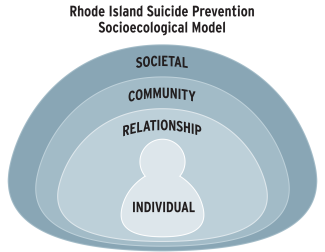Suicide Prevention Framework

We prevent suicide by increasing protective factors and decreasing risk factors. Looking at the model, you can see how positive things–such as a good relationship with your doctor, restrictions on lethal means, and a healthy school environment–would contribute to a lowered risk of suicide. Or, how the more challenges a person experiences in their life and environment, such as substance use, violent relationships, and barriers to accessing mental healthcare, might put them at higher risk for suicide.

PROTECTIVE FACTORS
- Availability of physical & mental healthcare
- Restrictions on lethal means of suicide
RISK FACTORS
- Availability of lethal means of suicide
- Unsafe media portrayals of suicide
PROTECTIVE FACTORS
- Safe & supportive school & community environments
- Continued care after psychiatric hospitalization
RISK FACTORS
- Few available sources of supportive relationships
- Barriers to healthcare (e.g., lack of access to providers)
PROTECTIVE FACTORS
- Connectedness to individuals, family, community & social institutions
- Supportive relationships with healthcare providers
RISK FACTORS
- High conflict or violent relationships
- Family history of suicide
PROTECTIVE FACTORS
- Coping & problem-solving skills
- Reasons for living (e.g., children in attempt the home)
RISK FACTORS
- Mental illness
- Substance use
- Previous suicide attempt
- lmpulsivity/aggression